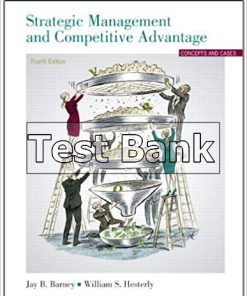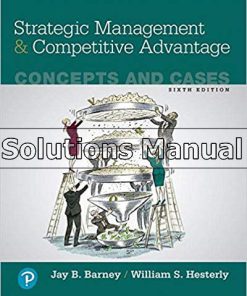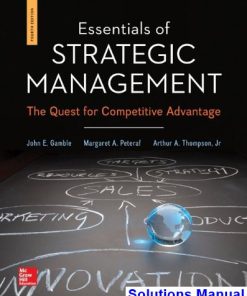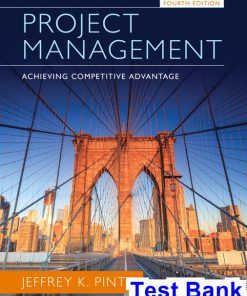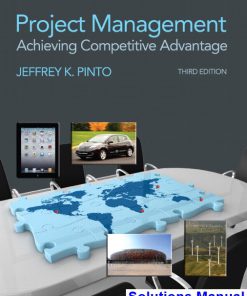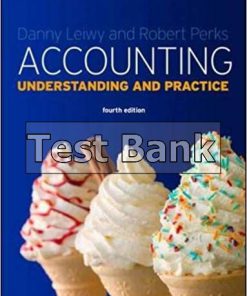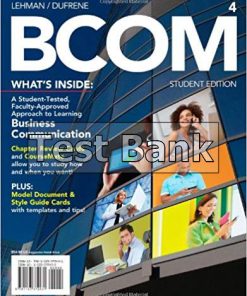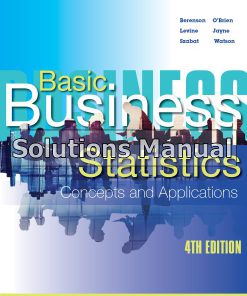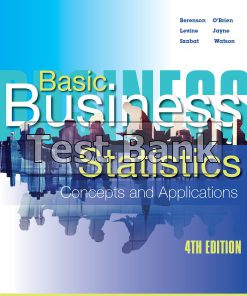Project Management Achieving Competitive Advantage 4th Edition Pinto Solutions Manual
$26.50$50.00 (-47%)
Project Management Achieving Competitive Advantage 4th Edition Pinto Solutions Manual.
You may also like
This is completed downloadable of Project Management Achieving Competitive Advantage 4th Edition Pinto Solutions Manual
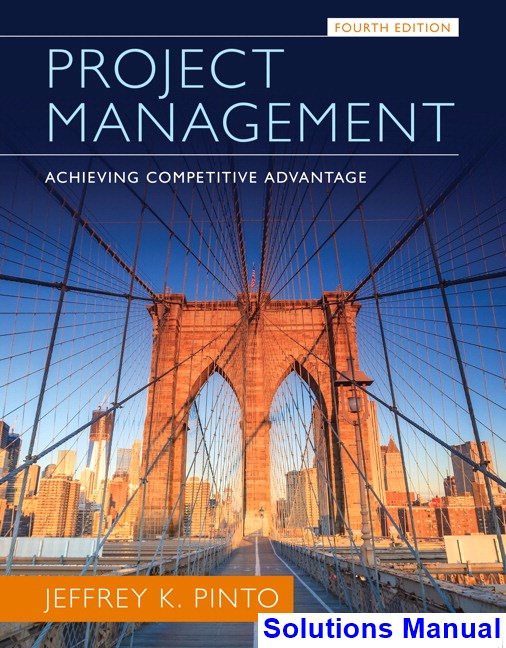
Product Details:
- ISBN-10 : 0133798070
- ISBN-13 : 978-0133798074
- Author:
In its Fourth Edition, Project Management: Achieving Competitive Advantage takes a contemporary, decisive, and business-oriented approach to teaching and learning project management. Blending current theory, contemporary case studies, and hands-on practice and research, Project Management offers students a full range of perspectives of the project management process.
Table of Content:
- 1.1 What Is a Project?
- General Project Characteristics
- 1.2 Why Are Projects Important?
- Project Profile: “Throwing Good Money after Bad”: the BBC’s Digital Media Initiative
- 1.3 Project Life Cycles
- Box 1.1: Project Managers in Practice
- 1.4 Determinants of Project Success
- Box 1.2: Project Management Research in Brief
- 1.5 Developing Project Management Maturity
- 1.6 Project Elements and Text Organization
- Summary
- Key Terms
- Discussion Questions
- Case Study 1.1 MegaTech, Inc.
- Case Study 1.2 The IT Department at Hamelin Hospital
- Case Study 1.3 Disney’s Expedition Everest
- Case Study 1.4 Rescue of Chilean Miners
- Internet Exercises
- PMP Certification Sample Questions
- Notes
- The Organizational Context: Strategy, Structure, and Culture
- Project Profile: Tesla’s $5 Billion Gamble
- Introduction
- 2.1 Projects and Organizational Strategy
- 2.2 Stakeholder Management
- Identifying Project Stakeholders
- Managing Stakeholders
- 2.3 Organizational Structure
- 2.4 Forms of Organizational Structure
- Functional Organizations
- Project Organizations
- Matrix Organizations
- Moving to Heavyweight Project Organizations
- Box 2.1: Project Management Research in Brief
- 2.5 Project Management Offices
- 2.6 Organizational Culture
- How Do Cultures Form?
- Organizational Culture and Project Management
- Project Profile: Electronic Arts and the Power of Strong Culture in Design Teams
- Summary
- Key Terms
- Discussion Questions
- Case Study 2.1 Rolls-Royce Corporation
- Case Study 2.2 Classic Case: Paradise Lost—The Xerox Alto
- Case Study 2.3 Project Task Estimationand the Culture of “Gotcha!”
- Case Study 2.4 Widgets ’R Us
- Internet Exercises
- PMP Certification Sample Questions
- Integrated Project—Building Your Project Plan
- Notes
- Project Selection and Portfolio Management
- Project Profile: Project Selection Procedures: A Cross-Industry Sampler
- Introduction
- 3.1 Project Selection
- 3.2 Approaches to Project Screening and Selection
- Method One: Checklist Model
- Method Two: Simplified Scoring Models
- Limitations of Scoring Models
- Method Three: The Analytical Hierarchy Process
- Method Four: Profile Models
- 3.3 Financial Models
- Payback Period
- Net Present Value
- Discounted Payback
- Internal Rate of Return
- Choosing a Project Selection Approach
- Project Profile: Project Selection and Screening at GE: The Tollgate Process
- 3.4 Project Portfolio Management
- Objectives and Initiatives
- Developing a Proactive Portfolio
- Keys to Successful Project Portfolio Management
- Problems in Implementing Portfolio Management
- Summary
- Key Terms
- Solved Problems
- Discussion Questions
- Problems
- Case Study 3.1 Keflavik Paper Company
- Case Study 3.2 Project Selection at Nova Western, Inc.
- Internet Exercises
- Notes
- Leadership and the Project Manager
- Project Profile: Leading by Example for the London Olympics—Sir John Armitt
- Introduction
- 4.1 Leaders Versus Managers
- 4.2 How the Project Manager Leads
- Acquiring Project Resources
- Motivating and Building Teams
- Having a Vision and Fighting Fires
- Communicating
- Box 4.1: Project Management Research in Brief
- 4.3 Traits of Effective Project Leaders
- Conclusions about Project Leaders
- Project Profile: Dr. Elattuvalapil Sreedharan, India’s Project Management Guru
- 4.4 Project Champions
- Champions—Who Are They?
- What Do Champions Do?
- How to Make a Champion
- 4.5 The New Project Leadership
- Box 4.2: Project Managers in Practice
- Project Profile: The Challenge of Managing Internationally
- 4.6 Project Management Professionalism
- Summary
- Key Terms
- Discussion Questions
- Case Study 4.1 In Search of Effective Project Managers
- Case Study 4.2 Finding the Emotional Intelligence to Be a Real Leader
- Case Study 4.3 Problems with John
- Internet Exercises
- PMP Certification Sample Questions
- Notes
- Scope Management
- Project Profile: “We look like fools.”—Oregon’s Failed Rollout of Its Obamacare Web Site
- Introduction
- 5.1 Conceptual Development
- The Statement of Work
- The Project Charter
- Project Profile: Statements of Work: Then and Now
- 5.2 The Scope Statement
- The Work Breakdown Structure
- Purposes of the Work Breakdown Structure
- The Organization Breakdown Structure
- The Responsibility Assignment Matrix
- 5.3 Work Authorization
- Project Profile: Defining a Project Work Package
- 5.4 Scope Reporting
- Box 5.1: Project Management Research in Brief
- 5.5 Control Systems
- Configuration Management
- 5.6 Project Closeout
- Summary
- Key Terms
- Discussion Questions
- Problems
- Case Study 5.1 Boeing’s Virtual Fence
- Case Study 5.2 California’s High-Speed Rail Project
- CaseStudy 5.3 Project Management at Dotcom.com
- Case Study 5.4 The Expeditionary Fighting Vehicle
- Internet Exercises
- PMP Certification Sample Questions
- MS Project Exercises
- Appendix 5.1: Sample Project Charter
- Integrated Project—Developing the Work Breakdown Structure
- Notes
- Project Team Building, Conflict, and Negotiation
- Project Profile: Engineers Without Borders: Project Teams Impacting Lives
- Introduction
- 6.1 Building the Project Team
- Identify Necessary Skill Sets
- Identify People Who Match the Skills
- Talk to Potential Team Members and Negotiate with Functional Heads
- Build in Fallback Positions
- Assemble the Team
- 6.2 Characteristics of Effective Project Teams
- A Clear Sense of Mission
- A Productive Interdependency
- Cohesiveness
- Trust
- Enthusiasm
- Results Orientation
- 6.3 Reasons Why Teams Fail
- Poorly Developed or Unclear Goals
- Poorly Defined Project Team Roles and Interdependencies
- Lack of Project Team Motivation
- Poor Communication
- Poor Leadership
- Turnover Among Project Team Members
- Dysfunctional Behavior
- 6.4 Stages in Group Development
- Stage One: Forming
- Stage Two: Storming
- Stage Three: Norming
- Stage Four: Performing
- Stage Five: Adjourning
- Punctuated Equilibrium
- 6.5 Achieving Cross-functional Cooperation
- Superordinate Goals
- Rules and Procedures
- Physical Proximity
- Accessibility
- Outcomes of Cooperation: Task and Psychosocial Results
- 6.6 Virtual Project Teams
- Project Profile: Tele-Immersion Technology Eases the Useof Virtual Teams
- 6.7 Conflict Management
- What Is Conflict?
- Sources of Conflict
- Methods for Resolving Conflict
- 6.8 Negotiation
- Questions to Ask Prior to the Negotiation
- Principled Negotiation
- Invent Options for Mutual Gain
- Insist on Using Objective Criteria
- Summary
- Key Terms
- Discussion Questions
- Case Study 6.1 Columbus Instruments
- Case Study 6.2 The Bean Counterand the Cowboy
- Case Study 6.3 Johnson & Rogers Software Engineering, Inc.
- Exercise in Negotiation
- Internet Exercises
- PMP Certification Sample Questions
- Notes
- Risk Management
- Project Profile: The Building that Melted Cars
- Introduction
- Box 7.1: Project Managers in Practice
- 7.1 Risk Management: a Four-Stage Process
- Risk Identification
- Project Profile: Bank of America Completely Misjudges Its Customers
- Risk Breakdown Structures
- Analysis of Probability and Consequences
- Risk Mitigation Strategies
- Use of Contingency Reserves
- Other Mitigation Strategies
- Control and Documentation
- Project Profile: Collapse of Shanghai Apartment Building
- 7.2 Project Risk Management: An Integrated Approach
- Summary
- Key Terms
- Solved Problem
- Discussion Questions
- Problems
- Case Study 7.1 Classic Case: deHavilland’s Falling Comet
- Case Study 7.2 The Spanish Navy Pays Nearly $3 Billion for a Submarine That Will Sink Like a Stone
- Case Study 7.3 Classic Case: Tacoma Narrows Suspension Bridge
- Internet Exercises
- PMP Certification Sample Questions
- Integrated Project—Project Risk Assessment
- Notes
- Cost Estimation and Budgeting
- Project Profile: Sochi Olympics—What’s the Cost of National Prestige?
- 8.1 Cost Management
- Direct Versus Indirect Costs
- Recurring Versus Nonrecurring Costs
- Fixed Versus Variable Costs
- Normal Versus Expedited Costs
- 8.2 Cost Estimation
- Learning Curves in Cost Estimation
- Box 8.1: Project Management Research in Brief
- Problems with Cost Estimation
- Box 8.2: Project Management Research in Brief
- 8.3 Creating a Project Budget
- Top-Down Budgeting
- Bottom-Up Budgeting
- Activity-Based Costing
- 8.4 Developing Budget Contingencies
- Summary
- Key Terms
- Solved Problems
- Discussion Questions
- Problems
- Case Study 8.1 The Hidden Costs of Infrastructure Projects—The Case of Building Dams
- Case Study 8.2 Boston’s Central Artery/Tunnel Project
- Internet Exercises
- PMP Certification Sample Questions
- Integrated Project—Developing the Cost Estimates and Budget
- Notes
- Project Scheduling: Networks, Duration Estimation, and Critical Path
- Project Profile: After 20 Years and More Than $50 Billion, Oil is No Closer to the Surface: The Casp
- Introduction
- 9.1 Project Scheduling
- 9.2 Key Scheduling Terminology
- 9.3 Developing a Network
- Labeling Nodes
- Serial Activities
- Concurrent Activities
- Merge Activities
- Burst Activities
- 9.4 Duration Estimation
- 9.5 Constructing the Critical Path
- Calculating the Network
- The Forward Pass
- The Backward Pass
- Probability of Project Completion
- Laddering Activities
- Hammock Activities
- Options for Reducing the Critical Path
- Box 9.1: Project Management Research in Brief
- Summary
- Key Terms
- Solved Problems
- Discussion Questions
- Problems
- Internet Exercises
- MS Project Exercises
- PMP Certification Sample Questions
- Notes
- Project Scheduling: Lagging, Crashing, and Activity Networks
- Project Profile: Enlarging the Panama Canal
- Introduction
- 10.1 Lags in Precedence Relationships
- Finish to Start
- Finish to Finish
- Start to Start
- Start to Finish
- 10.2 Gantt Charts
- Adding Resources to Gantt Charts
- Incorporating Lags in Gantt Charts
- Box 10.1: Project Managers in Practice
- 10.3 Crashing Projects
- Options for Accelerating Projects
- Crashing the Project: Budget Effects
- 10.4 Activity-on-Arrow Networks
- How Are They Different?
- Dummy Activities
- Forward and Backward Passes with AOA Networks
- AOA Versus AON
- 10.5 Controversies in the Use of Networks
- Conclusions
- Summary
- Key Terms
- Solved Problems
- Discussion Questions
- Problems
- Case Study 10.1 Project Scheduling at Blanque Cheque Construction (A)
- Case Study 10.2 Project Scheduling at Blanque Cheque Construction (B)
- MS Project Exercises
- PMP Certification Sample Questions
- Integrated Project—Developing the Project Schedule
- Notes
- Advanced Topics in Planning and Scheduling: Agile and Critical Chain
- Project Profile: Developing Projects Through Kickstarter—Do Delivery Dates Mean Anything?
- Introduction
- 11.1 Agile Project Management
- What Is Unique About Agile PM?
- Tasks Versus Stories
- Key Terms in Agile PM
- Steps in Agile
- Sprint Planning
- Daily Scrums
- The Development Work
- Sprint Reviews
- Sprint Retrospective
- Problems with Agile
- Box 11.1: Project Management Research in Brief
- 11.2 Extreme Programming (XP)
- 11.3 the Theory of Constraints and Critical Chain Project Scheduling
- 11.4 the Critical Chain Solution to Project Scheduling
- Developing the Critical Chain Activity Network
- Critical Chain Solutions Versus Critical Path Solutions
- Project Profile: Eli Lilly Pharmaceuticals and Its Commitment to Critical Chain Project Management
- 11.5 Critical Chain Solutions to Resource Conflicts
- 11.6 Critical Chain Project Portfolio Management
- Box 11.2: Project Management Research in Brief
- 11.7 Critiques of CCPM
- Summary
- Key Terms
- Solved Problem
- Discussion Questions
- Problems
- Case Study 11.1 It’s an Agile World
- Case Study 11.2 Ramstein Products, Inc.
- Internet Exercises
- Notes
- Resource Management
- Project Profile: Hong Kong Connects to the World’s Longest Natural Gas Pipeline
- Introduction
- 12.1 The Basics of Resource Constraints
- Time and Resource Scarcity
- 12.2 Resource Loading
- 12.3 Resource Leveling
- Step One: Develop the Resource-Loading Table
- Step Two: Determine Activity Late Finish Dates
- Step Three: Identify Resource Overallocation
- Step Four: Level the Resource-Loading Table
- 12.4 Resource-Loading Charts
- Box 12.1: Project Managers in Practice
- 12.5 Managing Resources in Multiproject Environments
- Schedule Slippage
- Resource Utilization
- In-Process Inventory
- Resolving Resource Decisions in Multiproject Environments
- Summary
- Key Terms
- Solved Problem
- Discussion Questions
- Problems
- Case Study 12.1 The Problems of Multitasking
- Internet Exercises
- MS Project Exercises
- PMP Certification Sample Questions
- Integrated Project—Managing Your Project’s Resources
- Notes
- Project Evaluation and Control
- Project Profile: New York City’s City Time Project
- Introduction
- 13.1 Control Cycles—a General Model
- 13.2 Monitoring Project Performance
- The Project S-Curve: A Basic Tool
- S-Curve Drawbacks
- Milestone Analysis
- Problems with Milestones
- The Tracking Gantt Chart
- Benefits and Drawbacks of Tracking Gantt Charts
- 13.3 Earned Value Management
- Terminology for Earned Value
- Creating Project Baselines
- Why Use Earned Value?
- Steps in Earned Value Management
- Assessing a Project’s Earned Value
- 13.4 Using Earned Value to Manage a Portfolio of Projects
- Project Profile: Earned Value at Northrop Grumman
- 13.5 Issues in the Effective Use of Earned Value Management
- 13.6 Human Factors in Project Evaluation and Control
- Critical Success Factor Definitions
- Conclusions
- Summary
- Key Terms
- Solved Problem
- Discussion Questions
- Problems
- Study 13.1 The IT Department at Kimble College
- Case Study 13.2 The Superconducting Supercollider
- Case Study 13.3 Boeing’s 787 Dreamliner: Failure to Launch
- Internet Exercises
- MS Project Exercises
- PMP Certification Sample Questions
- Appendix 13.1: Earned Schedule*
- Notes
- Project Closeout and Termination
- Project Profile: Duke Energy and Its Cancelled Levy County Nuclear Power Plant
- Introduction
- 14.1 Types of Project Termination
- Box 14.1: Project Managers in Practice
- 14.2 Natural Termination—the Closeout Process
- Finishing the Work
- Handing Over the Project
- Gaining Acceptance for the Project
- Harvesting the Benefits
- Reviewing How It All Went
- Putting It All to Bed
- Disbanding the Team
- What Prevents Effective Project Closeouts?
- 14.3 Early Termination for Projects
- Making the Early Termination Decision
- Project Profile: Aftermath of a “Feeding Frenzy”: Dubai and Cancelled Construction Projects
- Shutting Down the Project
- Box 14.2: Project Management Research in Brief
- Allowing for Claims and Disputes
- 14.4 Preparing the Final Project Report
- Conclusion
- Summary
- Key Terms
- Discussion Questions
- Case Study 14.1 New Jersey Kills Hudson River Tunnel Project
- Case Study 14.2 The Project That Wouldn’t Die
- Case Study 14.3 The Navy Scraps Development of Its Showpiece Warship—Until the Next Bad Idea
- Internet Exercises
- PMP Certification Sample Questions
- Appendix 14.1: Sample Pages from Project Sign-off Document
- Notes
- Appendix A The Cumulative Standard Normal Distribution
- Appendix B Tutorial for MS Project 2013
- Appendix C Project Plan Template
- Glossary
- Company Index
- Name Index
- Subject Index
People Also Search:
project management achieving competitive advantage pinto
project management achieving competitive advantage 4th edition pinto
project management achieving competitive advantage 4th edition
project management achieving competitive advantage 4th edition download scribd
project management achieving competitive advantage 4th edition solution manual download pdf

